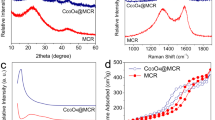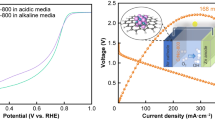Abstract
The slow reaction kinetics of oxygen reduction reaction (ORR) and oxygen evolution reaction (OER) during the charging and discharging process result in inferior cycle life and low-energy conversion efficiency of commercial zinc-air batteries (ZABs). Stannic oxide (SnO2) has received increasing attention for its unique advantages such as low cost, good stability, and high catalytic activity. In present work, mesoporous nanosphere carbon@stannic oxide (C@SnO2) core–shell structures with C as the inner layer and SnO2 as the outer shell are successfully prepared. When C@SnO2 serves as the cathode for ZABs, its specific surface area (245 m2 g−1) provides amounts of chemically active sites for ORR and OER. Similarly, carbon can not only increase the electrical conductivity of electrocatalyst, but also act as a support body for the core–shell structure which gives the material a robust structure and distinctive morphology. When C@SnO2 are employed as cathode in ZABs, it exhibits excellent electrocatalytic activity with half-wave potential (0.88 V) for ORR and onset potential (1.45 V) for OER. In addition, it shows a superior charging-discharging cycle stability. This work offers an insight for the selection and preparation of high-performance electrocatalysts.








Similar content being viewed by others
Data Availability
The data that support the findings of this study are available from the corresponding author upon reasonable request.
References
Liu B, Li JZ, Gong XF et al (2020) Facile synthesis of flower-like dual-metal (Co/Zn) MOF-derived 3D porous Co@Co-NPC as reversible oxygen electrocatalyst for rechargeable zinc-air batteries. Ionics 26(4):1913–1922
Chen L, Cui LL, Wang Z et al (2020) Co8FeS8/N, S-doped carbons derived from Fe-Co/S-bridged polyphthalocyanine: efficient dual-function air-electrode catalysts for rechargeable Zn-air batteries. ACS Sustain Chem Eng 8(35):13147–21315
Du D, Zhu Z, Chan KY et al (2022) Photoelectrochemistry of oxygen in rechargeable Li–O2 batteries. Chem Soc Rev 51:1846–1860
Zhu Z, Ni Y, Lv Q et al (2021) Surface plasmon mediates the visible light-responsive lithium-oxygen battery with Au nanoparticles on defective carbon nitride. P Natl A Sci 118(17):e2024619118
Zhu Z, Lv Q, Ni Y et al (2022) Internal electric field and interfacial bonding engineered step-scheme junction for a visible-light-involved lithium-oxygen battery. Angew Chem Int Edit 61(12):e202116699
Guo B, Ju Q, Ma R et al (2019) Mechanochemical synthesis of multi-site electrocatalysts as bifunctional zinc-air battery electrodes. J Mater Chem A 7(33):19355–19363
Li Y, Dai H (2014) Recent advances in zinc–air batteries. Chem Soc Rev 43(15):5257–5275
Li B, Quan J, Loh A et al (2017) A robust hybrid Zn-battery with ultralong cycle life. Nano Lett 17(1):156–163
Xu H, Ci S, Ding Y et al (2019) Recent advances in precious metal-free bifunctional catalysts for electrochemical conversion systems. J Mater Chem A 7:8006–8029
Fu J, Cano ZP, Park MG et al (2017) Electrically rechargeable zinc–air batteries: progress, challenges, and perspectives. Adv Mater 29(7):1604685
Han SC, Hu XY, Wang JC et al (2018) Novel route to Fe-based cathode as an efficient bifunctional catalysts for rechargeable Zn–air battery. Adv Energy Mater 8(22):1800955
Wang YQ, Tao L, **ao ZH et al (2018) 3d carbon electrocatalysts in situ constructed by defect-rich nanosheets and polyhedrons from NaCl-sealed zeolitic imidazolate frameworks. Adv Funct Mater 28(11):1705356
Shao M, Peles A, Shoemaker K et al (2011) Enhanced oxygen reduction activity of platinum monolayer on gold nanoparticles. J Phys Chem Lett 2(2):67–72
Li Y, Gong M, Liang Y et al (2013) Advanced zinc-air batteries based on high-performance hybrid electrocatalysts. Nature Commun 4:1805
Martinez U, Babu SK, Holby EF et al (2019) Progress in the development of Fe-based PGM-free electrocatalysts for the oxygen reduction reaction. Adv Mater 31(31):1806545–1806551
**ao J, Xu Y, **a Y et al (2016) Ultra-small Fe2N nanocrystals embedded into mesoporous nitrogen-doped graphitic carbon spheres as a highly active, stable, and methanol-tolerant electrocatalyst for the oxygen reduction reaction. Nano Energy 24:121–129
Jörissen L (2006) Bifunctional oxygen/air electrodes. J Power Sources 155(1):23–32
You TH, Hu CC (2018) Designing binary Ru–Sn oxides with optimized performances for the air electrode of rechargeable zinc–air batteries. ACS Appl Mater Interfaces 10(12):10064–10075
Zhang Y, Zhou Q, Zhu J et al (2017) Nanostructured metal chalcogenides for energy storage and electrocatalysis. Adv Funct Mater 27(35):1702317
Pan J, Tian XL, Zaman S et al (2019) Recent progress on transition metal oxides as bifunctional catalysts for lithium-air and zinc-air batteries. Batter Supercaps 2(4):336–347
Wang YJ, Fan H, Ignaszak A et al (2018) Compositing doped-carbon with metals, non-metals, metal oxides, metal nitrides and other materials to form bifunctional electrocatalysts to enhance metal-air battery oxygen reduction and evolution reactions. Chem Eng J 348(1):416–437
Novoselov KS, Geim AK, Morozov SV et al (2004) Electric field effect in atomically thin carbon films. Science 306:666
Liu X, Dai L (2016) Carbon-based metal-free catalysts Nat Rev Mater 1(11):16064
Prato M (1997) Fullerene chemistry for materials science applications. J Mater Chem 7(7):1097–1109
Ng SH, Wang J, Guo ZP et al (2005) Single wall carbon nanotube paper as anode for lithium-ion battery. Electrochim Acta 51(1):23–28
Zhang C, Peng X, Guo Z et al (2012) Carbon-coated SnO2/graphene nanosheets as highly reversible anode materials for lithium ion batteries. Carbon 50(5):1897–1903
Shi H, Shen Y, He F et al (2014) Recent advances of doped carbon as non-precious catalysts for oxygen reduction reaction. J Mater Chem A 2(38):15704–15716
Hu C, Dai L (2016) Carbon-based metal-free catalysts for electrocatalysis beyond the ORR. Angew Chem Int Ed 55(39):11736–11758
Zhu X, Hu C, Amal R et al (2020) Heteroatom-doped carbon catalysts for zinc–air batteries: progress, mechanism, and opportunities. Energy Environ Sci 13(12):4536–4563
Chen P, Tong Y, Wu C et al (2018) Surface/interfacial engineering of inorganic low-dimensional electrode materials for electrocatalysis. Accounts Chem Res 51(11):2857–2866
Li F, Zhao X, Mahmood J et al (2017) Macroporous inverse opal-like MoxC with incorporated Mo vacancies for significantly enhanced hydrogen evolution. ACS Nano 11:7527
Ma R, Lin G, Zhou Y et al (2019) A review of oxygen reduction mechanisms for metal-free carbon-based electrocatalysts. NPJ Comput Mater 5(1):1–15
Norek M, Michalska-Domańska M, Stepniowski WJ et al (2013) Multi-band emission in a wide wavelength range from tin oxide/Au nanocomposites grown on porous anodic alumina substrate (AAO). Appl Surf Sci 287:143–149
Kumar V, Singh K, Sharma J et al (2017) Zn-doped SnO2 nanostructures: structural, morphological and spectroscopic properties. J Mater Sci-Mater El 28(24):18849–18856
Yan J, Lin Z, Cai Q et al (2020) Choline chloride-modified SnO2 achieving high output voltage in MAPbI3 perovskite solar cells. ACS Appl Energy Mater 3(4):3504–3511
Choi PG, Izu N, Shirahata N et al (2019) SnO2 nanosheets for selective alkene gas sensing. ACS Appl Nano Mater 2(4):1820–1827
Hu N, Lv X, Dai Y et al (2018) SnO2/reduced graphene oxide interlayer mitigating the shuttle effect of Li-S batteries. ACS Appl Mater Interfaces 10(22):18665–18674
Chao G, Zhang L, Tian J et al (2021) Pd-SnO2 heterojunction catalysts anchored on graphene sheets for enhanced oxygen reduction. Compos Commun 25:100703
Meng G, Chang Z, Cui X et al (2021) SnO2/CeO2 nanoparticle-decorated mesoporous ZSM-5 as bifunctional electrocatalyst for HOR and ORR. Chem Eng J 417:127913
Hussain S, Kongi N, Erikson H et al (2019) Platinum nanoparticles photo-deposited on SnO2-C composites: an active and durable electrocatalyst for the oxygen reduction reaction. Electrochim Acta 316:162–172
Shen X, Yang F, Zhou L et al (2019) Dual-site cascade oxygen reduction mechanism on SnOx/Pt-Cu-Ni for promoting reaction kinetics. J Am Chem Soc 141:9463–9467
Cheng Y, Li Q, Wang C et al (2017) Large-scale fabrication of core–shell structured C/SnO2 hollow spheres as anode materials with improved lithium storage performance. Small 13(47):1701993
Feng H, **e P, Xue S et al (2018) Synthesis of three-dimensional porous reduced graphene oxide hydrogel/carbon dots for high-performance supercapacitor. Electroanal Chem 808:321–328
Feng H, Zhang C, Liu Z, et al (2022) A light-activated TiO2@ In2Se3@ Ag3PO4 cathode for high-performance Zn-Air batteries. Chem Eng J 134650.
Funding
This work is supported by the Shanghai Sailing Program from Science and Technology Committee of Shanghai (No. 21YF1416200).
Author information
Authors and Affiliations
Corresponding author
Ethics declarations
Conflict of interest
The authors declare no competing interests.
Additional information
Publisher's note
Springer Nature remains neutral with regard to jurisdictional claims in published maps and institutional affiliations.
Supplementary Information
Below is the link to the electronic supplementary material.
Rights and permissions
Springer Nature or its licensor (e.g. a society or other partner) holds exclusive rights to this article under a publishing agreement with the author(s) or other rightsholder(s); author self-archiving of the accepted manuscript version of this article is solely governed by the terms of such publishing agreement and applicable law.
About this article
Cite this article
Zeng, P., Zhang, C., Ding, M. et al. Core–shell C@SnO2 as bifunctional cathode electrocatalyst for high performance Zn-air batteries. Ionics 29, 1149–1157 (2023). https://doi.org/10.1007/s11581-022-04854-3
Received:
Revised:
Accepted:
Published:
Issue Date:
DOI: https://doi.org/10.1007/s11581-022-04854-3




